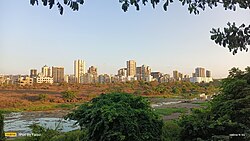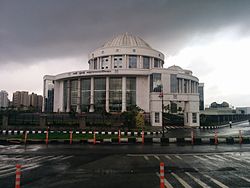Navi Mumbai
Navi Mumbai is a planned satellite city of Mumbai, on the west coast of Maharashtra in India. It was developed in 1972 as a new urban township of Mumbai, and is currently the largest planned city in the world.
|
नवी मुंबई New Bombay | |
|---|---|
Township | |
 | |
| Coordinates: 19°01′N 73°01′E / 19.02°N 73.02°ECoordinates: 19°01′N 73°01′E / 19.02°N 73.02°E | |
| Country | India |
| State | Maharashtra |
| District | Thane |
| Metro | Mumbai |
| Named for | New Bombay |
| Vidhan Sabha constituency | N BOM Mumbai(New Mumbai) |
History
Navi Mumbai, in the eastern harbour of Mumbai, is one of the world's largest planned townships. Since independence,[1][2][3] there was a specific reason to build a new city on the mainland across the harbour: to lower the population of Mumbai, an island city whose physical expansion had a limit.[4] It was regarded as an alternative for the many people who wanted to come to Mumbai from all over India. This decision required the Maharashtra government to relocate its seat of governance along with all its important offices to this new city, and completely stop the backbay reclamation project in the island city. It did not do this. It continued with the reclamation and put brakes on the efforts of CIDCO (such as the shifting of wholesale markets).[5][6]
Planned city

Planning of Navi Mumbai did not fully begin until 1971.[4] South Navi Mumbai is being quickly developed with modern infrastructure in parts of Kharghar, Kamothe, New Panvel and Kalamboli.[7]
CIDCO Development
The City and Industrial Development Corporation (CIDCO) was formed on 17 March 1971, under the Indian Companies Act, 1956. The area covered 150 kilometres (93 mi) of the total 720 kilometres (450 mi) of the Konkan coast. Privately owned land with 86 villages covering 15,954 hectares (39,420 acres) within the present limits of Navi Mumbai and further villages measuring an additional 2,870 hectares (7,100 acres) were acquired by the government of Maharashtra.
CIDCO carved out 16 nodes small townships with a view towards facilitating comprehensive development. These nodes are named Airoli, Ghansoli, Kopar Khairane, Juhu Nagar, Vashi, Turbhe, Sanpada, Nerul, CBD Belapur, Kharghar, Kamothe, New Panvel, Taloja, Kalamboli, Ulwe, and Dronagiri. CIDCO acquired 193.94 square kilometres (74.88 sq mi) of land, of which 141.05 square kilometres (54.46 sq mi) was private land, 22.92 square kilometres (8.85 sq mi) salt-pan land and 52.89 square kilometres (20.42 sq mi) government land. By 2000, CIDCO had developed about 117.60 square kilometres (45.41 sq mi) of land. Of this land, 54.45 square kilometres (21.02 sq mi) is saleable under various land uses. CIDCO has sold about 21.90 square kilometres (8.46 sq mi) leaving a balance land for sale about 32.58 square kilometres (12.58 sq mi) under various land uses.
CIDCO planned and constructed all the railway stations in Navi Mumbai and developed nearby areas commercially.

In 1973, the Vashi bridge was opened to the public for residents of Vashi, CBD Belapur and Nerul. The Sion-Panvel Expressway was built to reduce the time taken to travel from Sion to Panvel. Initially there was not much response to the new city. Major changes took place only after 1990, with the commissioning of a wholesale agricultural produce market at Vashi and the construction of a commuter railway line from Mankhurd to Vashi in May 1992. These developments caused a sudden growth in economic activities and population in Navi Mumbai.
Recent Developments
By the end of the 1990s, the planning authority of Navi Mumbai started private participation in the developmental activity of Navi Mumbai.
A new railway line between Nerul and Uran was opened on 12 Jan 2024 by Shri Narendra Modi, Prime Minister of India. Kharghar and Panvel are experiencing major infrastructural developments due to their being close to the proposed Navi Mumbai International Airport.
Administration
NMMC
On 17 December 1991, Navi Mumbai Municipal Corporation (NMMC) was created by the state government for maintaining some of the developed nodes of Navi Mumbai.
Local self-government started on 1 January 1992. NMMC was handed nine of the 25 nodes of the Navi Mumbai project area for its administration. However, CIDCO, as a planning authority, has rights on the open plots in these five nodes.
The nine nodes maintained by NMMC are CBD Belapur, Nerul, Vashi, Juhu Nagar, Turbhe, Kopar khairane, Ghansoli, Airoli, Digha, and Sanpada as of 1 January 1998, with the physical and social infrastructure already in place.
With annual budget exceeding Navi Mumbai Municipal Corporation, it is rated amongst the richest corporations in Maharashtra.
The municipal corporation is headed by a municipal commissioner and an elected mayor. There are 64 electoral wards in Navi Mumbai. A corporator is elected for each of the wards.
The newly developed nodes of Navi Mumbai on the south: Kharghar, Kamothe, New Panvel and Kalamboli are still maintained by CIDCO. These nodes, which are all beyond CBD Belapur, come under the Raigad district and are under the maintenance of CIDCO.
Statistics
As per provisional reports of Census India, population of Navi Mumbai as of 2011 is 1,119,477; of which male and female are 611,501 and 507,976 respectively. Although Navi Mumbai city has population of 1,119,477; its urban population is 18,414,288 of which 9,894,088 are males and 8,520,200 are females.
In education section, total number of literates in Navi Mumbai city are 911,542 of which 519,257 are males while 392,285 are females. Average literacy rate of Navi Mumbai city is 91.57 percent of which male and female literacy was 95.05 and 87.33 percent. The sex ratio of Navi Mumbai city is 831 females per 1000 males. Child sex ratio is 901 girls per 1000 boys.
Skyline of Nerul, Navi Mumbai
Palm Beach Road in Nerul
NMMC Main Building, CBD Belapur
References
- ↑ Master Plan in Outline by Modak and Mayer (no date given, probably publ.1947).
- ↑ Report of a Study Group on Greater Bombay, Govt. of Maharashtra,1961 (the Barve Group ).
- ↑ Gadgil Planning Committee. Report of the Committee appointed for Bombay-Panvel and Poona regions. Bombay: Government Press, 1965.
- ↑ 4.0 4.1 The Urban Social Pattern of Navi Mumbai, India by Malathi Ananthakrishnan, April, 1998, Blacksburg, Virginia p 4
- ↑ Verma, H. S. (1984). Bombay, New Bombay and Metropolitan Region: Growth process and planning lessons. Concept Publishing Company. p. 157.
- ↑ Shaw, Annapurna (2004). The Making of Navi Mumbai. Orient Blackswan. pp. 107–108.
- ↑ Gotsch, Peter (2009). NeoTowns – Prototypes of Corporate Urbanism. Archived from the original on 2013-09-29. Retrieved 2013-06-07.












